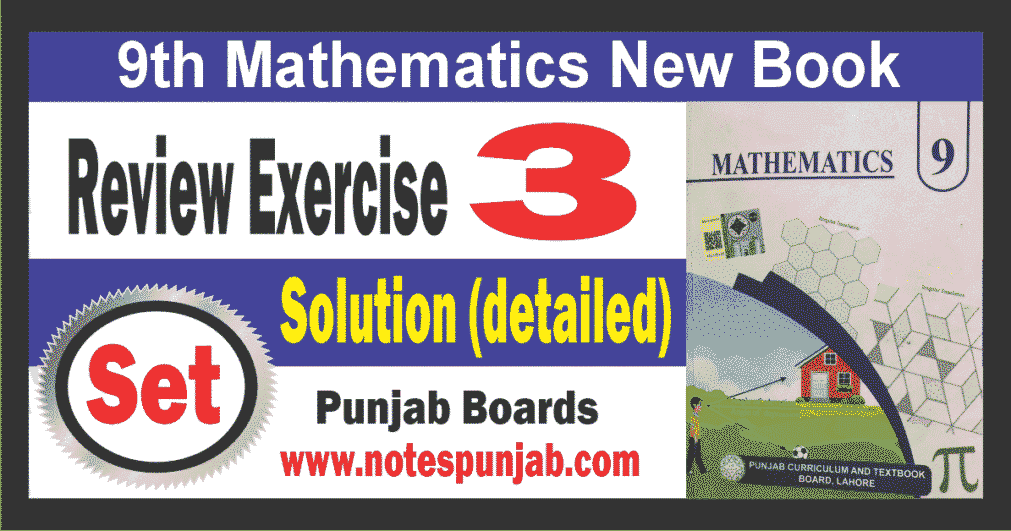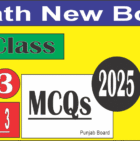9th Math Review Exercise 3 Notes Punjab
9th Math Review Exercise 3 New Book will be completely solved.
Q1 Four options are given against each statement. Encircle the correct option.
(i) The set builder of the form
$$\{\;1,\;\frac13,\;\frac15,\;\frac17,…\}\;is:$$
$$(a)\;\{\;x\;\vert x\;=\frac1n,n\in W\;\}$$
$$(b)\;\{\;x\;\vert x\;=\frac1{2n+1},n\in W\;\}$$
$$(c)\;\{\;x\;\vert x\;=\frac1{n+1},n\in W\;\}$$
$$(d)\;\{\;x\;\vert x\;=2n+1,n\in W\;\}$$
Correct option is (b)
==========================================
(ii) If A = { }, then P(A) is:
(a) { }
(b) { 1 }
(c) { { } }
$$(d)\;\phi$$
Correct option is (c)
==========================================
(iii) If U = { 1, 2, 3, 4, 5 }, A = { 1, 2, 3 } and B = { 3, 4, 5 }, then
$$U-(\;A\cap B\;)\;is:$$
(a) {1,2,4,5}
(b) {2,3}
(c) {1,3,4,5}
(d) {1,2,3}
Correct option is (a)
==========================================
(iv) If A and B are overlapping sets, then n(A-B) is equal to
(a) n (A)
(b) n (B)
$$(c)\;A\cap B\;$$
$$(d)\;n(A)\;-\;n(A\cap B)$$
Correct option is (d)
==========================================
(v) If
$$A\;\subseteq B\;and\;B-A\;\neq\phi,\;then\;B-A\;is\;equal\;to$$
(a) 0
(b) n(B)
(c) n(A)
(d) n(B) – n(A)
Correct option is (d)
==========================================
(vi) If n(AUB) = 50, n(A) = 30 and n(B) = 35, then
$$n(A\cap B)\;=:$$
(a) 23
(b) 15
(c) 9
(d) 40
Correct option is (b)
==========================================
(vii) If A = { 1, 2, 3, 4 } and B = { x, y, z }, then cartesian product of A and B contains exactly _______ element.
(a) 13
(b) 12
(c) 10
(d) 6
Correct option is (b)
==========================================
(viii) If
$$f\mathit(x\mathit)\mathit\;\mathit=\mathit\;x^{\mathit2}\mathit-\mathit\;\mathit3x\mathit\;\mathit+\mathit\;\mathit2\mathit,\mathit\;then\mathit\;\\the\mathit\;value\mathit\;of\mathit\;\mathrm f(\;\mathrm a+1\;)\;\mathrm{is}\;\mathrm{equal}\;\mathrm{to}:$$
(a) a+1
$$(b)\;a^2+1\\(c)\;a^2+2a+1\\(d)\;a^2-a$$
Correct option is (d)
==========================================
(ix) Given that f(x) = 3x + 1, if f(x) = 28, then the value of x is:
(a) 9
(b) 27
(c) 3
(d) 18
Correct option is (a)
==========================================
(x) Let A = {1, 2, 3 } and B = {a, b } two non-empty sets and
$$f\;:\;A\rightarrow B$$
be a function defined as f = { (1,a).(2,b),(3,b) }, then which of the following statement is true ?
(a) f is injective
(b) f is surjective
(c) f is bijective
(d) f is into only
Correct option is (b)
9th Math Review Exercise 3 New Book Subjective Questions
Q2 Write each of the sets in tabular form
Solution:-
We will write tabular as well as descriptive forms of the sets
(i)
$$\{x\vert x=2n,\;n\in\mathbb{N}\}$$
Tabular Form
{2,4,6,8,….}
Descriptive Form
The set of all Even Natural Numbers.
(ii)
$$\{x\vert x=2m+1,\;m\in\mathbb{N}\}$$
Tabular Form
{3,5,7,9,….}
Descriptive Form
The set of all Odd Natural numbers greater than 1
(iii)
$$\{x\vert x=11n,\;n\in W\wedge n<11\}$$
Tabular Form
{0,11,22,….,110}
Descriptive Form
The set of first eleven non negative multiples of eleven.
(iv)
$$\{x\vert x\in E\wedge4<x<6\}$$
Tabular Form
{ }
Descriptive Form
The set of Even numbers between 4 and 6
(v)
$$\{x\vert x\in O\wedge5\;\leq x<7\}$$
Tabular Form
{ 5 }
Descriptive Form
The set of Odd numbers between 5 and 7 including 5.
(vi)
$$\{x\vert x\in\mathbb{Q}\wedge x^2=2\}$$
Tabular Form
{ }
Descriptive Form
Set of all rational numbers whose square is two.
But No such rational number exists.
(vii)
$$\{x\vert x\in\mathbb{Q}\wedge x=-x\}$$
Tabular Form
{0}
Descriptive Form
The set of all rational numbers equal to their own negative.
0 is the only number
(viii)
$$\{x\vert x\in\mathbb{R}\wedge x\not\in\mathbb{Q}’\}$$
Tabular Form
Q
Descriptive Form
The set that does not belong to irrational numbers i.e set of all rational numbers
Q3 Let U={1,2,3,4,5,6,7,8,9,10}, A={2,4,6,8,10}, B={1,2,3,4,5} and C={1,3,5,7,9}. List the member of each of the following sets.
(i) A’
(ii) B’
(iii) AUB
(iv) A-B
$$(v)\;\;A\cap C$$
(vi) A’UC’
(vii) A’UC
(viii) U’
Solution:-
(i)
A’=U-A={1,2,3,4,5,6,7,8,9,10}-{2,4,6,8,10}
A’ = {1,3,5,7,9}
(ii)
B’=U-B={1,2,3,4,5,6,7,8,9,10}-{1,2,3,4,5}
B’ = {6,7,8,9,10}
(iii)
AUB={2,4,6,8,10}U{1,2,3,4,5}
AUB = {1,2,3,4,5,6,8,10}
(iv)
A-B ={2,4,6,8,10}-{1,2,3,4,5}
A-B = {6,8,10}
(v)
$$A\cap B=\{2,4,6,8,10\}\cap\{1,3,5,7,9\}=\phi$$
(vi)
A’UC’={1,3,5,7,9}U{2,4,6,8,10}
A’UB’={1,2,3,4,5,6,7,8,9,10}=U
(vii)
A’UC={1,3,5,7,9}U{1,3,5,7,9}
A’UC = {1,3,5,7,9}
(viii)
$$U’=U-U=\phi$$
Q4 Using the Venn diagram, if necessary, find the single sets equal to the following $$(i)\;A’\;\;(ii)\;A\cap U\;(iii)\;A\cup U\\(iv)\;A\cup\phi\;\;(v)\;\;\phi\cap\phi$$
(i) Complement of set A means the set of all elements of universal set U which does not belong to set A.
A’ = U – A
(ii) Intersection of set A and universal set U means common elements of set A and universal set U
$$A\cap U=A$$
(iii) Union of set A and universal set U means all elements of universal set U
$$A\cup U=U$$
(iv) Union of set A and empty set means all elements of set A
$$A\cup\phi=A$$
(v) Intersection of two empty sets means empty set
$$\phi\cup\phi=\phi$$
Q5 Use Venn diagrams to verify the following:
(i)
$$A\;-\;B\;=\;A\cap B’$$
(ii)
$$(A-B)’\cap B=B$$
Q6 Verify the properties for the sets A, B and C given below: (i) Associativity of Union (ii) Associativity of intersection (iii) Distributivity of Union over intersection (iv) Distributivity of intersection over union (a) A={1,2,3,4}, B={3,4,5,6,7,8}, C={5,6,7,9,10} (b) A= { }, B={0}, C={0,1,2} (c) A=N, B=Z, C=Q
(i)
Associativity of union
AU(BUC) = (AUB)UC
(a)
BUC = {3,4,5,6,7,8}U{5,6,7,9,10}
= { 3,4,5,6,7,8,9,10 }
AU(BUC)={1,2,3,4}U{3,4,5,6,7,8,910}
={1,2,3,4,5,6,7,8,9,10}
AUB={1,2,3,4}U{3,4,5,6,7,8}
={1,2,3,4,5,6,7,8}
(AUB)UC={1,2,3,4,5,6,7,8}U{5,6,7,9,10}
={1,2,3,4,5,6,7,8,910}
Hence AU(BUC) = (AUB)UC
(b)
Associativity of union
AU(BUC) = (AUB)UC
BUC = {0}U{0,1,2}
= { 0,1,2 }
AU(BUC)={ }U{0,1,2}
={0,1,2}
AUB={ }U{0}
={0}
(AUB)UC={0}U{0,1,2}
={0.1.2}
Hence AU(BUC) = (AUB)UC
(c)
Associativity of union
AU(BUC) = (AUB)UC
BUC = ZUQ=Q
AU(BUC)=NUQ=Q
AUB=NUZ=Z
(AUB)UC=ZUQ=Q
Hence AU(BUC) = (AUB)UC
(ii)
$$Associativity\;of\;intersection\\A\cap(B\cap C)=(A\cap B)\cap C$$
(a)
$$B\cap C=\{3,4,5,6,7,8\}\cap\{5,6,7,9,10\}\\=\{5,6,7\}$$
$$A\cap(B\cap C)=\{1,2,3,4\rbrack\cap\{5,6,7\}=\phi$$
L.H.S = { }
$$A\cap B=\{1,2,3,4\}\cap\{3,4,5,6,7,8\}\\=\;\{\;3,4\;\}$$
$$(A\cap B)\cap C=\{3,4\}\cap\{5,6,7,9,10\}\\=\;\phi$$
R.H.S = { }
Hence. L.H.S = R.H.S
(b)
$$B\cap C=\{0\}\cap\{0,1,2\}\\=\{\;0\;\}$$
$$A\cap(B\cap C)=\{\;\;\}\;\cap\{\;\;0\;\}\\=\{\;\;\}$$
L.H.S = { }
$$A\cap B=\{\;\;\}\;\cap\{\;\;0\;\}\\=\{\;\;\}$$
$$(A\cap B)\cap C=\{\;\;\}\;\cap\;\{0,1,2\}\\=\{\;\;\}$$
R.H.S = { }
Hence L.H.S = R.H.S
(c)
$$B\cap C=\mathbb{Z}\cap\mathbb{Q}=\mathbb{Z}\\A\cap(B\cap C)=\mathbb{N}\cap\mathbb{Z}=\mathbb{N}$$
$$A\cap B=\mathbb{N}\cap\mathbb{Z}=\mathbb{N}\\(A\cap B)\cap C=\mathbb{N}\cap\mathbb{Q}=\mathbb{N}$$
Hence
$$A\cap(B\cap C)=(A\cap B)\cap C=\mathbb{N}$$
(iii)
Distributivity of Union over intersection
$$A\cup(B\cap C)=(A\cup B)\cap(A\cup C)$$
(a)
$$B\cap C=\{3,4,5,6,7,8\}\cap\{5,6,7,9,10\}\\=\;\{\;5,6,7\;\}$$
$$A\cup(B\cap C)=\{1,2,3,4\}\cap\{5,6,7\}\\=\;\{\;1,2,3,4,5,6,7\;\;\}$$
L.H.S = { 1,2,3,4,5,6,7 }
$$A\cup B=\{1,2,3,4\}\cup\{3,4,5,6,7,8\}\\=\;\{\;1,2,3,4,5,6,7,8\;\}\\A\cup C=\{1,2,3,4\}\cup\{5,6,7,9,10\}\\=\;\{\;1,2,3,4,5,6,7,9,10\;\}$$
$$(A\cup B)\cap(AUC)\\=\{1,2,3,4,5,6,7,8\}\cap\{1,2,3,4,5,6,7,9,10\}\\=\{\;1,2,3,4,5,6,7\;\}$$
R.H.S = { 1,2,3,4,5,6,7 }
Hence
L.H.S = R.H.S
(b)
$$B\cap C=\{\;0\;\}\;\cap\;\{\;0,1,2\;\}\\=\;\{\;0\;\}$$
$$A\cup(B\cap C)=\{\;\;\}\;\cup\;\{\;0\;\}\\=\;\{\;0\;\}$$
L.H.S = { 0 }
$$A\cup B=\{\;\}\cup\{\;0\;\}\;=\;\{\;0\;\}\\A\cup C=\{\;\}\cup\{\;0,1,2\;\}=\{\;0,1,2\;\}$$
$$(A\cup B)\cap A\cup C\\=\{0\}\cap\{0,1,2\}\\=\{\;0\;\}$$
R.H.S = { 0 }
Hence
L.H.S = R.H.S
(c)
$$B\cap C=\mathbb{Z}\;\cap\;\mathbb{Q}=\mathbb{Z}\\A\cup(B\cap C)=\mathbb{N}\cup\mathbb{Z}=\mathbb{Z}$$
$$A\cup B=\mathbb{N}\cup\mathbb{Z}\;=\;\mathbb{Z}\\A\cup C=\mathbb{N}\cup\mathbb{Q}=\mathbb{Q}\\(A\cup B)\cap(A\cup C)\\=\mathbb{Z}\cap\mathbb{Q}=\mathbb{Z}$$
Hence
$$A\cup(B\cap C)=(A\cup B)\cap(A\cup C)$$
(iv)
Distributivity of intersection over union
$$A\cap(B\cup C)=(A\cap B)\cup(A\cap C)$$
(i)
$$B\cup C=\{3,4,5,6,7,8\}\cup\{5,6,7,9,10\}\\=\{\;3,4,5,6,7,8,9,10\;\}\\A\cap(B\cup C)=\{1,2,3,4\}\cap\{3,4,5,6,7,8,9,10\}\\=\;\{\;\;3\;,\;4\;\}$$
L.H.S = { 3 , 4 }
$$A\cap B=\{1,2,3,4\}\cap\{3,4,5,6,7,8\}\\=\;\{\;3\;,\;4\;\}\\A\cap C=\{1,2,3,4\}\cap\{5,6,7,9,10\}\\=\;\{\;\;\}$$
$$(A\cap B)\cup(A\cap C)=\{3,4\}\cup\{\;\}\\=\;\{\;3\;,\;4\;\}$$
R.H.S = { 3 , 4 }
Hence L.H.S = R.H.S
(ii)
$$B\cup C=\{0\}\cup\{0,1,2\}\\=\{\;0,1,2\;\}\\A\cap(B\cup C)=\{\;\}\cap\{0,1,2\}\\=\;\{\;\;\}$$
L.H.S = { }
$$A\cap B=\{\;\}\cap\{0\}\\=\;\{\;\;\}\\A\cap C=\{\;\}\cap\{0,1,2\}\\=\;\{\;\;\}$$
$$(A\cap B)\cup(A\cap C)=\{\;\}\cup\{\;\}\\=\;\{\;\}$$
R.H.S = { }
Hence L.H.S = R.H.S
(iii)
$$B\cup C=\;\mathbb{Z}\cup\mathbb{Q}\;=\;\mathbb{Q}\\A\cap(B\cup C)=\mathbb{N}\cap\mathbb{Q}=\mathbb{N}$$
$$A\cap B=\mathbb{N}\cap\mathbb{Z}=\mathbb{N}\\A\cap C=\mathbb{N}\cap\mathbb{Q}=\mathbb{N}\\(A\cap B)\cup(A\cap C)=\mathbb{N}\cup\mathbb{N}=\mathbb{N}$$
Hence
$$A\cap(B\cup C)=(A\cap B)\cup(A\cap C)$$
Q7 Verify De Morgan’s Laws for the following sets.
U={1,2,3,…,20}, A={2,4,6,…,20}, B={1,3,5,…,19}
Solution:- De Morgan’s Laws
$$(A\cup B)’\;=\;A’\cap B’\\(A\cap B)’\;=\;A’\cup B’\\$$
AUB={2,4,6,…,20}U{1,3,5,…,19}
={1,2,3,…,20}
(AUB)’=U-(AUB)
={1,2,3,…,20}-{1,2,3,…,20}={ }
L.H.S = { }
A’=U-A
={1,2,3,…,20}-{2,4,6,…,20}
={1,3,5,…,19}
B’=U-B
={1,2,3,…,20}-{1,3,5,…,19}
={2,4,6,…,20}
$$A’\cap B’=\{1,3,5,…,19\}\cap\{2,4,6,…,20\}\\=\;\{\;\}\\$$
R.H.S = { }
Hence, L.H.S = R.H.S
$$A\cap B=\{2,4,6,…,20\}\cap\{1,3,5,…,19\}\\=\{\;\}\\(A\cap B)’=\cup-(A\cap B)\\=\{1,2,3,…,20\}-\{\;\}\\=\{1,2,3,…,20\}\\$$
$$A’=\cup-A\\=\{1,2,3,…,20\}-\{2,4,6,…,20\}\\=\{1,3,5,…,19\}\\B’=\cup-B\\=\{1,2,3,…,20\}-\{1,3,5,…,19\}\\=\{2,4,6,…,20\}\\A’\cup B’=\{1,3,5,…,19\}\cup\{2,4,6,…,20\}\\=\{1,2,3,…,20\}\\\\$$
Hence
$$(A\cap B)’=A’\cup B’\\\\$$
Q8 Consider the set
$$P=\{x\vert x=5m,\;m\in\mathbb{N}\}\;and\\Q=\{x\vert x=2m,m\in\mathbb{N}\}.\;Find\;P\cap Q\\\\$$
Solution:-
$$P=\{x\vert x=5m,\;m\in\mathbb{N}\}\\P=\{5,10,15,20,25,30,…..\}\\\\Q=\{x\vert x=2m,m\in\mathbb{N}\}.\\Q=\{2,4,6,8,10,12,14,16,18,20,…..\}\\\\$$
$$P\cap Q=\{10,20,30,…..\}\\\\$$
Q9 From suitable properties of union and intersection, deduce the following results:
$$(i)\;\;A\cap(A\cup B)=A\cup(A\cap B)\\(ii)\;A\cup(A\cap B)=A\cap(A\cup B)$$
Solution:-
(i)
$$L.H.S=\;A\cap(A\cup B)$$
Distributivity of intersection over union
$$=(A\cap A)\cup(A\cap B)$$
Idempotent law of intersection
$$=A\cup(A\cap B)=R.H.S$$
(ii)
$$L.H.S=\;A\cup(A\cap B)$$
Distributivity of union over intersection
$$=(A\cup A)\cap(A\cup B)$$
Idempotent law of union
$$=A\cap(A\cup B)=R.H.S$$
Q10:- If
$$g(x)=7x-2\\s(x)=8x^2-3\;find:$$
(i)g(0) (ii)g(-1) (iii)g(-5/3) (iv)s(1) (v)s(-9) (vi)s(7/2)
Solution:-
(i)
g(x) = 7x – 2
g(0) = 7(0) – 2
g(0) = 0 – 2 = -2
(ii)
g(x) = 7x – 2
g(-1) = 7(-1) – 2
g(-1) = -7 – 2 = -9
(iii)
g(x) = 7x – 2
g(-5/3) = 7(-5/3) – 2
g(0) = -35/3 – 2 = -41/3
(iv)
$$s(x)=8x^2-3\\s(1)=8{(1)}^2-3\\=8(1)-3\\=8-3=5$$
(v)
$$s(x)=8x^2-3\\s(-9)=8{(-9)}^2-3\\=8(81)-3\\=648-3=645$$
(vi)
$$s(x)=8x^2-3\\s(7/2)=8{(7/2)}^2-3\\=8(49/4)-3\\=2(49)-3\\=98-3=95$$
Q11 Given that f(x)=ax+b, where a and b are constant numbers. If f(-2)=3 and f(4)=10, then find the values of a and b.
f(x) = ax+b
f(-2) = a(-2)+b
3 = -2a+b (i)
f(x) = ax+b
f(4) = a(4)+b
10 = 4a+b (ii)
Subtracting equation (ii) from equation (i)
3-10 = -2a+b-4a-b
-7 = -6a
a = 7/6
Putting the value of a in equation (i)
3 = -2(7/6) + b
3 = -7/3 + b
7/3 +3 = b
b = 16/3
Q12 Consider the function defined by k(x)=7x-5. If k(x)=100, find the value of x.
k(x)=7x-5 (i)
k(x)=100 (ii)
Equating Equation (i) and Equation (ii)
100 = 7x-5
100+5 = 7x
7x = 105
x = 105/7
x = 15
Q13 Consider the function
$$g(x)\;=mx^2\;+\;n$$
where m and n are constant numbers. If g(4)=20 and g(0)=5. Find the value of m and n.
$$g(x)\;=mx^2\;+\;n\\g(4)\;=\;m{(4)}^2\;+\;n\\20\;=\;16m\;+\;n\;\;(i)$$
$$g(x)\;=mx^2\;+\;n\\g(0)\;=\;m{(0)}^2\;+\;n\\5\;=\;0\;+\;n\\n\;=\;5\;\;(ii)$$
Putting n=5 in equation (i)
20 = 16m+5
20-5 = 16m
15 = 16m
m = 15/16
9th Math Review Exercise 3 Principle of Inclusions and Exclusion
Q14 A shopping mall has 100 products from various categories labelled 1 to 100, representing the universal set U. The products are categorized as follows:
Set A : Electronics, consisting of 30 products labelled from 1 to 30
and
Set B : Clothing comprises 25 products labelled from 31 to 55
and
Set C : Beauty products comprises 25 products labelled from 76 to 100
Write each set in tabular form, and find the union of all three sets.
Solution:-
U={1,2,3,….,100}
A={1,2,3,….,30}
B={31,32,33,….,55}
C={76,77,78,….100}
AUBUC={1,2,3,…,30,31,32,….,55,76,77,78,….,100}
n(A) = 30
n(B) = 25
n(C) = 25
n(AUBUC) = 30+25+25=80
Q15 Out of the 180 students who appeared in the annual examination, 120 passed the math test, 90 passed the science test, and 60 passed both the math and science test.
(a) How many passed either the math or science test ?
(b) How many did not pass either of the two tests ?
(c) How many passed the science test but not the math test ?
(d) How many failed the science test ?
Solution:-
Total students = n(U) = 180
Math = n(M) = 120
Science = n(S) = 90
$$Math\;and\;Science=n(M\cap S)=60$$
(a)
Principle of inclusion and exclusion
$$\vert M\cup S\vert=\vert M\vert+\vert S\vert-\vert M\cap S\vert\\\\\vert M\cup S\vert=120+90-60=150$$
(b)
n(U)-n(MUS)
=180-150=30
(c)
$$\vert S-M\vert=\vert S\vert-\vert M\cap S\vert\\\\=\;90-60\;=\;30$$
(d)
|U|-|S|
=180-90=90
Q16 In a software house of a city with 300 software developers, a survey was conducted to determine which programming languages are liked more. The survey revealed the following statistics:
150 developers like Python.
130 developers like Java.
120 developers like PHP.
70 developers like both Python and Java.
60 developers like both Python and PHP.
50 developers like both Java and PHP.
40 developers like all three languages: Python, Java and PHP.
(a) How many developers use at least one of these languages ?
(b) How many developers use only one of these languages ?
(c) How many developers do not use any of these languages ?
(d) How many developers use only PHP ?
Solution:-
Set of developers who like Python = P = 150
Set of developers who like Java = J = 130
Developers who like PHP = H = 120
$$Python\;and\;Java\;=\;P\cap J\;=\;70\\Python\;and\;PHP\;=\;P\cap H\;=\;60\\PHP\;and\;Java\;\;=\;\;H\cap J\;\;=50\\All\;three\;=\;\;P\cap J\cap H\;=\;40\\$$
(a) How many developers use at least one of these languages
Principle of inclusion and exclusion
$$\vert P\cup J\cup H\vert=\vert P\vert\cup\vert J\vert\cup\vert H\vert-\vert P\cap J\vert\\\;-\vert P\cap H\vert-\vert J\cap H\vert+\vert P\cap J\cap H\vert\\$$
= 150+130+120-70-60-50+40 = 250
250 developers use at least one of these languages
(b) How many developers use only one of these languages
$$Only\;Python=\vert P\vert-\vert P\cap J\vert\\\;-\vert P\cap H\vert+\vert P\cap J\cap H\vert\\$$
= 150 – 70 -60 +40 = 60
$$Only\;Java=\vert J\vert-\vert P\cap J\vert\\\;-\vert J\cap H\vert+\vert P\cap J\cap H\vert\\$$
= 130 – 70 -50 +40 = 50
$$Only\;PHP=\vert H\vert-\vert P\cap H\vert\\\;-\vert J\cap H\vert+\vert P\cap J\cap H\vert\\$$
= 120 – 60 -50 +40 = 50
Developers use only one of these languages = 60+50+50 = 160
160 developers use only one of these languages
(c) How many developers do not use any of these languages
Developers do not use any of these language = Total – |PUJUH|
= 300 – 250 = 50
(d) How many developers use only PHP
Already done in part (b)
$$Only\;PHP=\vert H\vert-\vert P\cap H\vert\\\;-\vert J\cap H\vert+\vert P\cap J\cap H\vert\\$$
= 120 – 60 -50 +40 = 50
Only 50 developers use PHP.
=======================================
Check! some important links below




